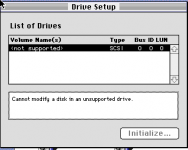Dave, it can be done; I was able to successfully create an sd card that I could use to boot an LC. I did not use the SCSI card method as I have no SCSI card in any of my PCs, instead i created a disk image manually and then installed to it within basilisk. i have written out below what I recall doing.
This is not exactly fresh in my mind and all of my vintage gear is in the closet

so ymmv, but I think you can read the partition map from any Apple Partition Map volume with the right size using the dd utility and then write it to the SD card. I retraced as much of this as I could on my OSX system today, but the Linux commands should be the same and you can get a port of 'dd' for windows if needed. Anyway, this is what I did, and I confirmed it will boot basilisk after being read back from the sd card into an image, and I think it will work on real hardware as well:
- Set up Basilisk II, attach 1MB Mac II ROM and disk image with self-extracting System 7 installer on it, and confirm it works.
- Then, I created a DMG file using the Apple Disk Utility (OSX 10.14.5) by setting the parameters as follows:
-- Partition type "Single Partition - Apple Partition Map" !!! don't pick the case sensitive version, I think it's for A/UX but in any case is not needed here.
-- Format type "MacOS Extended Journal" (will be changed by Basilisk)
-- Image format "read/write disk image"
-- Set size to match your SD card
-- Don't enable compression as we want a flat image.
- Open Basilisk II GUI and set up the Volumes tab with two entries, the first should be your MacOS installer .dsk image, then the new dmg file.
- Boot Basilisk II and let it format the new image, this will erase the MacOS Extended Journal partition and replace it with the HFS partition. it will also update the partition map entries
- Install MacOS onto the image
- Shutdown Basilisk II
- write to sd card: dd if=<dmg file> of=/dev/diskN where N is the device number of the SD card. Enter '/dev/diskN' not '/dev/diskNs0' on a mac ... linux will have different paths for the devices
Now I confirmed that the partition map is correct at this point by using the OSX 'diskutil list' command:
/dev/disk2 (external, physical):
#: TYPE NAME SIZE IDENTIFIER
0: Apple_partition_scheme *2.0 GB disk2
1: Apple_partition_map 32.3 KB disk2s1
2: Apple_HFS MacOS 2.0 GB disk2s2
/dev/disk3 (disk image):
#: TYPE NAME SIZE IDENTIFIER
0: Apple_partition_scheme +2.0 GB disk3
1: Apple_partition_map 32.3 KB disk3s1
2: Apple_HFS MacOS 2.0 GB disk3s2
I have checked that the SD card can be the source for a new, bootable image by reading it back in with dd again. They are identical so I would expect the SD card to work.
So at this point I'm pretty sure my SD card would work in an actual Mac in the SCSI2SD BUT there is a gotcha which is that some versions (? not sure maybe all) of System 7 need to have a 'System Enabler' for some the specific Mac model. See
http://www.savagetaylor.com/2015/11/23/macintosh-system-enablers-for-os-7-1-to-7-5-5-current-versions-and-change-history/ for more info. So just make sure you have the right one installed (via basilisk) before you write to the SD card.
All that said, if you have no Mac that's not a great help because you can't create the DMG file in the correct partition format. I'll attach a sample bootable image you can try. boot into Basilisk first and install the enabler, I used a IIci in the settings, 64mb ram 68030 and a performa rom.
View attachment system7.zip


